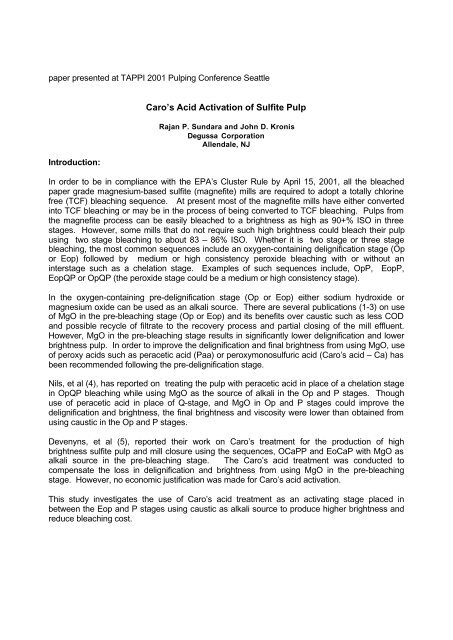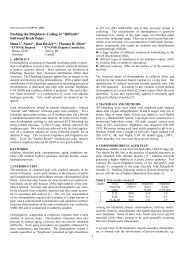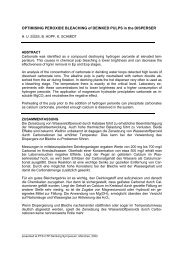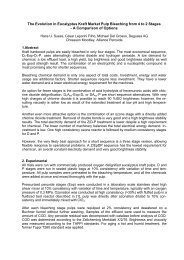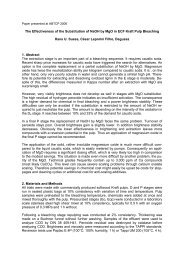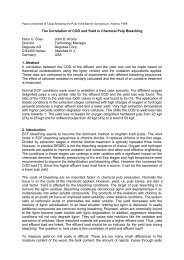Caro's Acid Activation of Sulfite Pulp
Caro's Acid Activation of Sulfite Pulp
Caro's Acid Activation of Sulfite Pulp
Create successful ePaper yourself
Turn your PDF publications into a flip-book with our unique Google optimized e-Paper software.
paper presented at TAPPI 2001 <strong>Pulp</strong>ing Conference Seattle<br />
Introduction:<br />
Caro’s <strong>Acid</strong> <strong>Activation</strong> <strong>of</strong> <strong>Sulfite</strong> <strong>Pulp</strong><br />
Rajan P. Sundara and John D. Kronis<br />
Degussa Corporation<br />
Allendale, NJ<br />
In order to be in compliance with the EPA’s Cluster Rule by April 15, 2001, all the bleached<br />
paper grade magnesium-based sulfite (magnefite) mills are required to adopt a totally chlorine<br />
free (TCF) bleaching sequence. At present most <strong>of</strong> the magnefite mills have either converted<br />
into TCF bleaching or may be in the process <strong>of</strong> being converted to TCF bleaching. <strong>Pulp</strong>s from<br />
the magnefite process can be easily bleached to a brightness as high as 90+% ISO in three<br />
stages. However, some mills that do not require such high brightness could bleach their pulp<br />
using two stage bleaching to about 83 – 86% ISO. Whether it is two stage or three stage<br />
bleaching, the most common sequences include an oxygen-containing delignification stage (Op<br />
or Eop) followed by medium or high consistency peroxide bleaching with or without an<br />
interstage such as a chelation stage. Examples <strong>of</strong> such sequences include, OpP, EopP,<br />
EopQP or OpQP (the peroxide stage could be a medium or high consistency stage).<br />
In the oxygen-containing pre-delignification stage (Op or Eop) either sodium hydroxide or<br />
magnesium oxide can be used as an alkali source. There are several publications (1-3) on use<br />
<strong>of</strong> MgO in the pre-bleaching stage (Op or Eop) and its benefits over caustic such as less COD<br />
and possible recycle <strong>of</strong> filtrate to the recovery process and partial closing <strong>of</strong> the mill effluent.<br />
However, MgO in the pre-bleaching stage results in significantly lower delignification and lower<br />
brightness pulp. In order to improve the delignification and final brightness from using MgO, use<br />
<strong>of</strong> peroxy acids such as peracetic acid (Paa) or peroxymonosulfuric acid (Caro’s acid – Ca) has<br />
been recommended following the pre-delignification stage.<br />
Nils, et al (4), has reported on treating the pulp with peracetic acid in place <strong>of</strong> a chelation stage<br />
in OpQP bleaching while using MgO as the source <strong>of</strong> alkali in the Op and P stages. Though<br />
use <strong>of</strong> peracetic acid in place <strong>of</strong> Q-stage, and MgO in Op and P stages could improve the<br />
delignification and brightness, the final brightness and viscosity were lower than obtained from<br />
using caustic in the Op and P stages.<br />
Devenyns, et al (5), reported their work on Caro’s treatment for the production <strong>of</strong> high<br />
brightness sulfite pulp and mill closure using the sequences, OCaPP and EoCaP with MgO as<br />
alkali source in the pre-bleaching stage. The Caro’s acid treatment was conducted to<br />
compensate the loss in delignification and brightness from using MgO in the pre-bleaching<br />
stage. However, no economic justification was made for Caro’s acid activation.<br />
This study investigates the use <strong>of</strong> Caro’s acid treatment as an activating stage placed in<br />
between the Eop and P stages using caustic as alkali source to produce higher brightness and<br />
reduce bleaching cost.
Experimental:<br />
Unbleached hardwood (aspen) sulfite pulp used in this study was obtained from a nearby<br />
magnefite mill. The Kappa number <strong>of</strong> the pulp as received was high, due to a large amount <strong>of</strong><br />
carryover chemical. To be representative <strong>of</strong> mill bleaching, the as-received pulp having a<br />
Kappa number <strong>of</strong> 44 was used in the Eop stage. Following the Eop stage, a peroxide bleaching<br />
stage was conducted both at medium consistency, represented as [P(MC)], and at high<br />
consistency, [P(HC)], at the conditions shown in the following table. In some experiments a<br />
chelation stage (Q) using EDTA or an activation step using Caro’s acid or Peracetic acid was<br />
conducted prior to the peroxide bleaching stage.<br />
The conditions used in each stage are furnished in the following table.<br />
Conditions Eop P(MC) P(HC) Q Paa Ca<br />
Stage Stage stage<br />
Consistency, % 12 12 30 4 12 12<br />
Temperature, o C 80 85 85 65 70 70<br />
O 2 -Pressure, MPa. 40<br />
Time, min 15+60 180 180 45 30 30<br />
pH 10.3 – 10.7 9 – 10 8 – 9 6.0 –6.5 4 – 4.5 5 – 7.0<br />
NaOH, % 5 – 5.3 0.9 – 1.7 0.3 – 0.75 0.9 – 2.8<br />
Peroxide, % 0.75 0.5 – 2.5 1 – 2.5<br />
EDTA, % 0.2<br />
Caro’s acid, % AO 0.1- 0.3<br />
Paa, % AO 0.1-0.3<br />
Peracetic acid used in this study is an equilibrium 35% concentration solution available from<br />
laboratory chemical supply companies.<br />
Caro’s acid (peroxymonosulfuric acid) was prepared in our laboratory using 70% peroxide and<br />
concentrated sulfuric acid with a conversion rate <strong>of</strong> 75 – 79%.<br />
<strong>Pulp</strong> washing following each stage <strong>of</strong> bleaching was conducted by diluting the pulp to 2%<br />
consistency and filtering through a Buchner funnel. The brightness (% ISO) <strong>of</strong> the pulp from<br />
each stage was measured by preparing two handsheets with 4.0 g OD pulp each and using a<br />
Technidyne brightness meter. The residual peroxide and COD <strong>of</strong> filtrates and viscosity <strong>of</strong> pulps<br />
from all the bleaching stages were measured using the corresponding Tappi Test Methods.<br />
Results and Discussion:<br />
The average brightness and Kappa number <strong>of</strong> Eop-bleached pulp were 66.4% ISO and 14.7,<br />
respectively.<br />
Effect <strong>of</strong> MC vs. HC Peroxide Bleaching and QP(MC) Bleaching:<br />
Figure 1 shows the brightness obtained from peroxide bleaching <strong>of</strong> Eop pulp at medium and<br />
high consistency conditions. Also, shown is the brightness obtained from bleaching the<br />
chelated pulp with peroxide at medium consistency.<br />
2
At a given peroxide charge, the high consistency peroxide bleaching yielded an average <strong>of</strong> 2<br />
points increase in brightness compared to medium consistency bleaching. Incorporating a<br />
chelation step prior to medium consistency peroxide bleaching, on the other hand, increased the<br />
brightness <strong>of</strong> the final pulp by about 2.5 – 3.0 points. Thus, a maximum brightness <strong>of</strong> 83% ISO<br />
was achieved from P(MC) with 2.5% peroxide compared to P(HC) which yielded a maximum<br />
brightness <strong>of</strong> 85.3% ISO with 2.5% peroxide. Incorporating a chelation increased the final<br />
brightness to about 86.3% ISO at 2.5% peroxide charge.<br />
Effect <strong>of</strong> Chelation vs. Caro’s acid (Ca) on Peroxide Bleaching:<br />
Figure 2 shows the results obtained from bleaching the Eop pulp using P(MC), QP(MC) and<br />
Ca(0.1%)P(MC) sequences.<br />
92<br />
Brightness (% ISO)<br />
90<br />
88<br />
QP(MC)<br />
86<br />
P(HC)<br />
84<br />
P(MC)<br />
82<br />
80<br />
78<br />
0.5 1 1.5 2 2.5 3<br />
Peroxide Charge (%)<br />
Figure 1.<br />
Brightness from Medium and High Consistency (MC and HC) Peroxide<br />
Bleaching <strong>of</strong> Eop <strong>Pulp</strong> and Medium Consistency Peroxide Bleaching<br />
<strong>of</strong> Eop-Chelated <strong>Pulp</strong><br />
Brightness (% ISO)<br />
92<br />
90<br />
88<br />
86<br />
84<br />
82<br />
80<br />
Ca(0.1%)P(MC)<br />
QP(MC)<br />
P(MC)<br />
78<br />
0.5 1 1.5 2 2.5 3<br />
Peroxide Charge (%)<br />
Figure 2.<br />
Brightness from Medium (MC) Peroxide Bleaching <strong>of</strong> Caro’s acid<br />
Activated, Chelated and Unchelated <strong>Pulp</strong>s.<br />
3
In the Caro’s acid activation step the Eop pulp was treated with 0.1, 0.2 and 0.3% Caro’s acid<br />
(Ca) expressed as active oxygen (AO). The three Ca-treated pulps were then bleached using<br />
0.5 – 2.0% peroxide in the subsequent stage at medium consistency. It is clear that including a<br />
chelation step provided only an average brightness gain <strong>of</strong> about 3 points over no chelation. On<br />
the other hand, treating the pulp with 0.1% Caro’s acid (as AO) boosted the brightness gain to<br />
about 6 - 7 points in the following peroxide bleaching [P(MC) stage] compared to untreated pulp.<br />
Alternatively, to reach a brightness <strong>of</strong> 84% ISO only 0.5% peroxide is required in the P stage<br />
with 0.1% Caro’s acid activation compared to a peroxide charge <strong>of</strong> 1.5% with chelation<br />
treatment. Thus, a reduction <strong>of</strong> about 1.0% peroxide was possible with 0.1% Caro’s activation<br />
prior to the P stage. Besides, it is clear that activation <strong>of</strong> Eop pulp using Caro’s acid could<br />
increase the brightness ceiling to as high as 89% ISO when additional peroxide is applied in the<br />
following P stage.<br />
Brightness (% ISO)<br />
92<br />
Ca(0.2%)P(MC)<br />
90<br />
88<br />
QP(MC)<br />
86<br />
84<br />
P(MC)<br />
82<br />
80<br />
Brightness (% ISO)<br />
92<br />
Ca(0.3%)P(MC)<br />
90<br />
88<br />
QP(MC)<br />
86<br />
84<br />
P(MC)<br />
82<br />
80<br />
78<br />
0.5 1 1.5 2 2.5 3<br />
78<br />
0.5 1 1.5 2 2.5 3<br />
Peroxide Charge (%)<br />
Peroxide Charge (%)<br />
Figure 3. Figure 4.<br />
Figures 3 and 4. Effect <strong>of</strong> 0.2 and 0.3% Caro’s <strong>Acid</strong> (AO) <strong>Activation</strong> compared to Chelation and<br />
no chelation on the following P-stage Brightness.<br />
When the Caro’s acid charged in the activation step was increased to 0.2% (AO) an additional<br />
brightness gain <strong>of</strong> about 2 points on average was obtained over 0.1% Caro’s acid treatment<br />
(Figure 3). Further increasing the Caro’s acid charge to 0.3%, however, did not provide<br />
significant further improvement in brightness gain (Figure 4).<br />
Figure 5 shows the results obtained from using peracetic acid (Paa) as an activating agent in<br />
place <strong>of</strong> Caro’s acid. Whether it is the activation by Caro’s acid or Paa, both yielded similar<br />
brightness gains in the following P-stage bleaching when equal amounts <strong>of</strong> AO are applied.<br />
This clearly indicates that both Caro’s acid and Paa at equal AO levels applied produced similar<br />
final brightness. Also, it is clear that the brightness gained from activation step using either<br />
peroxygen compound is far higher than those obtained from a chelation or no chelation step.<br />
Effect <strong>of</strong> <strong>Activation</strong> on Filtrate COD<br />
The total COD <strong>of</strong> the filtrates collected from the activation stage (Caro’s or Peracetic acid using<br />
0.1% and 0.3% AO charge) and the following peroxide stage are shown in Figure 6. It is clear<br />
that Caro’s activation <strong>of</strong> Eop pulp resulted in much lower COD both at 0.1 and 0.3% AO levels<br />
compared to peracetic acid-treated pulps. Only 10 – 12% increase in COD is seen when the<br />
amount <strong>of</strong> Caro’s acid applied was increased from 0.1% to 0.3% as AO. However, an increase<br />
4
about 45 – 58% in COD is seen when peracetic acid applied was increased from 0.1 to 0.3%<br />
AO.<br />
Brightness (% ISO)<br />
92<br />
90<br />
88<br />
86<br />
84<br />
82<br />
Ca or Paa (0.3%)P(MC)<br />
Ca or Paa (0.1%)P(MC)<br />
Ca or Paa (0.2%)P(MC)<br />
80<br />
0.5 1 1.5 2 2.5 3<br />
Peroxide Charge (%)<br />
Figure 5.<br />
Effect <strong>of</strong> Caro’s acid vs. Peracetic acid <strong>Activation</strong> on<br />
Brightness in the following P-stage Bleaching<br />
100<br />
80<br />
Paa(0.1%)P<br />
Paa(0.3%)P<br />
82<br />
87<br />
94 94<br />
100<br />
80<br />
Ca(0.1%)P<br />
Ca(0.3%)P<br />
COD (Kg/t)<br />
60<br />
40<br />
51<br />
57<br />
62<br />
65<br />
COD (Kg/t)<br />
60<br />
40<br />
39<br />
35<br />
54<br />
49<br />
46 47<br />
52<br />
58<br />
20<br />
20<br />
0<br />
0.5 1 1.5 2<br />
0<br />
0.5 1 1.5 2<br />
Peroxide (%)<br />
Peroxide (%)<br />
Figure 6.<br />
Total COD <strong>of</strong> Filtrates from <strong>Activation</strong> Stage (Paa or Caro’s acid)<br />
and following P stage.<br />
5
Effect <strong>of</strong> <strong>Activation</strong> Stage on <strong>Pulp</strong> Viscosity:<br />
Figures 7 and 8 show the viscosity <strong>of</strong> the peroxide bleached pulps following the Caro’s acid and<br />
Peracetic acid activation at 0.1% and 0.3% AO, respectively. Caro’s acid activation results in<br />
much higher viscosity retention compared to peracetic acid activation at both 0.1 and 0.3%<br />
levels <strong>of</strong> AO charges.<br />
50<br />
0.5% P 1.0% P 1.5% P 2.0% P<br />
Viscosity (mPa.s)<br />
40<br />
30<br />
20<br />
10<br />
33<br />
28<br />
25<br />
22<br />
41<br />
38<br />
28<br />
29<br />
0<br />
Paa(0.1%)P<br />
Bleach sequence<br />
Ca(0.1%)P<br />
Figure 7.<br />
Viscosity <strong>of</strong> Peroxide Bleached <strong>Pulp</strong>s from Caro’s <strong>Acid</strong> and<br />
Peracetic acid <strong>Activation</strong> at 0.1% AO<br />
50<br />
0.5% P 1.0% P 1.5% P 2.0% P<br />
Viscosity (mPa.s)<br />
40<br />
30<br />
20<br />
10<br />
27<br />
24<br />
19<br />
18<br />
37<br />
31<br />
26<br />
19<br />
0<br />
Paa(0.3%)P<br />
Bleach sequence<br />
Ca(0.3%)P<br />
Figure 8.<br />
Viscosity <strong>of</strong> Peroxide Bleached <strong>Pulp</strong>s from Caro’s <strong>Acid</strong> and<br />
Peracetic acid <strong>Activation</strong> at 0.3% AO.<br />
6
Comparison <strong>of</strong> Bleaching Cost: EopQP(MC) vs. EopCaP(MC)<br />
In this study a two-stage, EopP(MC) did not even reach a brightness <strong>of</strong> 84% ISO. To reach a<br />
brightness <strong>of</strong> 86% ISO using EopQP(MC) requires about 2% peroxide in the peroxide stage,<br />
besides 0.2% EDTA in the chelation stage. On the other hand, to achieve the same brightness<br />
it requires 0.1% Caro’s acid (as AO) with only 1% peroxide in the peroxide stage. Thus, a<br />
saving <strong>of</strong> about 1% peroxide and 0.2% chelant can be achieved by replacing the chelant with<br />
0.1% Caro’s and some amount <strong>of</strong> caustic to maintain the pH.<br />
The savings in bleaching cost obtainable from using 0.1% Caro’s acid with 1% peroxide plus<br />
some additional caustic clearly out weighs the cost <strong>of</strong> using 0.2% chelant and 2% peroxide to<br />
achieve 86% ISO. Besides, use <strong>of</strong> Caro’s acid could provide flexibility to the process to reach<br />
even higher brightnesses when needed with some additional peroxide.<br />
Comparison <strong>of</strong> Bleaching Cost: CaP vs. PaaP<br />
Figure 9 shows the cost ratio for bleaching using Caro’s acid vs. peracetic acid as activating<br />
agent for equal level <strong>of</strong> brightness. The bleaching cost for only the last two stages <strong>of</strong> CaP and<br />
PaaP are computed. The actual costs are then normalized using the cost <strong>of</strong> CaP bleaching = 1<br />
to get a cost ratio. The cost ratio for Caro’s acid vs. peracetic acid at 0.1% AO level indicates<br />
that the cost <strong>of</strong> peracetic activation is significantly higher than Caro’s acid activation at every<br />
level <strong>of</strong> peroxide applied in the following P-stage. The increase in bleaching cost for using<br />
peracetic acid as an activating agent is about 28% - 44% more than Caro’s acid activation,<br />
corresponding to a cost ratio <strong>of</strong> 1.28 – 1.44. However, the brightness achieved from Caro’s acid<br />
and peracetic acid at 0.1% AO are the same at each peroxide level (See Figure 5).<br />
2<br />
Ca(0.1)P<br />
Paa(0.1)P<br />
Cost Ratio<br />
1.5<br />
1<br />
0.5<br />
0<br />
1.0% P 1.5% P 2.0% P<br />
Figure 9. The Cost Ratio for Bleaching using CaP vs. PaaP sequence at 0.1% AO.<br />
7
2<br />
Ca(0.3)P<br />
Paa(0.3)P<br />
Cost Ratio<br />
1.5<br />
1<br />
0.5<br />
0<br />
1.0% P 1.5% P 2.0% P<br />
Figure 10. The Cost Ratio for Bleaching using CaP vs. PaaP sequence at 0.3% AO.<br />
When the applied AO is increased to 0.3%, the cost ratio <strong>of</strong> peracetic acid to Caro’s acid still<br />
follows the same trend but with an overall higher cost to achieve higher brightness (Figure 10).<br />
The cost ratio ranged between 1.51 – 1.67, indicating that it cost 51% to 67% more to bleach<br />
using peracetic acid than Caro’ s acid.<br />
Summary:<br />
1. Two-stage EopP bleaching using a medium consistency peroxide stage resulted in a<br />
maximum brightness <strong>of</strong> 83% ISO, while EopP bleaching a using high consistency peroxide<br />
stage resulted in about 2 points higher brightness to yield 85% ISO.<br />
2. Incorporating a chelating stage (0.2% EDTA) prior to medium consistency peroxide<br />
bleaching boosted the brightness achieved to 87% ISO, about 4 points higher than EopP<br />
bleaching.<br />
3. Substituting the chelation step with Caro’s or Peracetic acid activation, however, boosted<br />
the final brightness to a maximum <strong>of</strong> 90+% ISO.<br />
4. To achieve a brightness <strong>of</strong> 86% either EopQP bleaching with 0.2% chelant and 2%<br />
peroxide, or EopCaP bleaching with 0.1% Caro’s acid and 1% peroxide can be used.<br />
However, savings in bleaching cost from using 0.1% Caro’s acid with 0.1% peroxide clearly<br />
out weighs the QP bleaching.<br />
5. Further, Caro’s acid activation provides flexibility to the process to reach even higher<br />
brightnesses when needed with some additional peroxide.<br />
6. Both, Caro’s acid and Peracetic acid at all three levels <strong>of</strong> activation, 0.1, 0.2 and 0.3% AO,<br />
yielded the same level <strong>of</strong> brightness increase.<br />
8
7. However, the Caro’s acid activation resulted in a much lower filtrate COD compared to<br />
peracetic acid activation for the combined filtrates from the activation and the following P<br />
stages.<br />
8. Also, the Caro’s acid activation resulted in higher final pulp viscosity compared to peracetic<br />
acid activation.<br />
9. The cost <strong>of</strong> bleaching the sulfite pulp with Caro’s acid is significantly lower than with<br />
peracetic acid<br />
Thus, Caro’s acid is a better activation agent for sulfite pulp bleaching to achieve higher pulp<br />
brightness and viscosity and lower filtrate COD compared to peracetic acid or chelation<br />
treatment. Above all the cost <strong>of</strong> bleaching using Caro’s acid is far less than peracetic acid.<br />
References:<br />
1. Kronis, J.D; Nimmerfroh, N., Süss, H.U., Böttcher, H., Lüttgen, W., Geisenheiner, A., 1994<br />
International <strong>Pulp</strong> Bleaching Conference, P 247.<br />
2. Reisner, T.B., and Schl<strong>of</strong>fer, K., 1996 International Non-Chlorine Bleaching Conference,<br />
Orlando, Paper 9-2.<br />
3. Bokström, M., and Tigerström, A., Journal <strong>of</strong> <strong>Pulp</strong> & Paper Canada, Vol 92, No. 11: T279<br />
(1991).<br />
4. Nils, G., Johansson, and Fletcher, D.E., 1996 International <strong>Pulp</strong>ing Conference, p 481.<br />
5. Devenyns, J., Troughton, N., and Desprez, F., 1994 <strong>Pulp</strong>ing Conference, p 481.<br />
9


